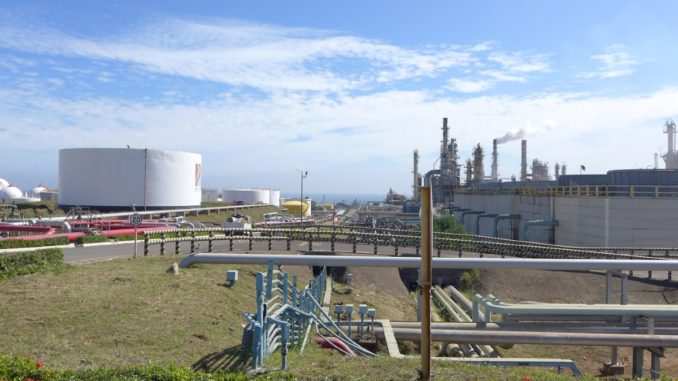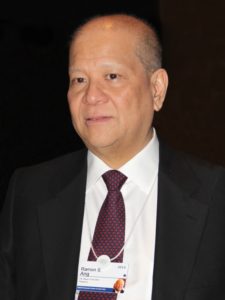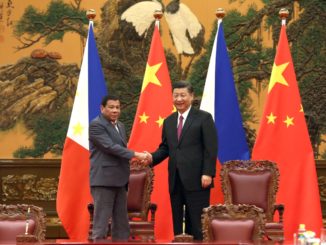

On Friday, Jan. 13, I joined San Miguel Corp. president and vice chairman Ramon S. Ang on a whirlwind helicopter tour of Petron Refinery’s 400-hectare industrial complex in Limay, Bataan. He was furious. Petron or more specifically, a brand-new SMC coal power plant was accused, in an ABS-CBN prime time newscast, of spewing dangerous ash fall onto a barrio, Sitio Pexsite, some five kms away from the refinery complex.
Upon landing, RSA took the driver’s seat of a Toyota van and drove his guests around the Petron industrial estate premises and then to the village where allegedly ABS-CBN has found victims of pollution of two San Miguel coal-fired power plants.
He also made sure we passed by the community hospital by the highway. There were no patients at that time (10:30 a.m.), unusual for a village that is supposed to be teeming with pollution victims.
Ramon is in his element. Especially when the SMC group is unfairly being accused, of all things – pollution. As the top honcho of San Miguel, he is a hands-on executive. An engineer by training, he loves details.
A keen entrepreneur, his mind works like a computer. He knows his topline and his bottomline from the palm of his hand. He taught himself many things – how to assemble, fix and repair motorcycles, cars, and huge industrial machinery. How to fly helicopters and planes. When our helicopter refused to start up on the return trip to Manila, he readily got off his seat and looked for the “red box” – the small spare battery that can jumpstart a failing ‘copter engine.
RSA is not just a man with a mind on details. He is also a businessman with a heart.
When Metro Manila was overwhelmed by Ondoy in 2009, SMC ordered a huge purchase of rubber boats for use the public in case of a similar emergency. When a Mindanao region was devastated by a howler a few years ago, he ordered his men to build 5,000 homes for those rendered homeless – for free. When he noticed that many of the Jesuits at Ateneo were aging, he donated P200 million to build a building (a hospital actually) for them where they can be cared for. He loves Ateneo and the Jesuits although he did not study there. His children though went to Ateneo.
San Miguel’s businesses are right down RSA’s alley. The conglomerate has more than 100 plants spread across the Philippines and Southeast Asia. Ramon is hurt when unfairly accused.
That’s why in the case of so-called San Miguel pollution, he took matters into his hands literally. He gave tv and media interviews. He also announced plans to build more coal plants – in the wrong places, like Basilan and Sulu. Why? For missionary reasons. He wants those depressed areas to be developed to curb the insurgency and reduce poverty.
The Channel 2 newscast even interviewed the mother of a three-year-old boy who had galis aso (scabies) and another person, a certain Mang Danny, who apparently was going blind because of alleged pollution. Danny said he was holding a tree trunk and suddenly there was a gust of strong wind and dust penetrated his eyes.
In the first place, scabies is caused not by pollution but by tiny mites that reside on the outer layer of the skin. Mites are living things, not an inanimate matter like ash or industrial dust.
In the second place, if it is true the SMC coal plant emits pollution, the first to be adversely affected should be Petron’s some 1,400 employees and residents in Limay.
I talked to Petron’s resident doctor of the past three years, Homer Paras. He said there had been no single case of scabies or eye infection at the Petron premises. So if Ground Zero has no pollution why would a barrio some 5 kms away have it?
In the third place, the source of the alleged pollution, SMC’s coal plant, could not have caused the ash fall because it is not yet operational. It will be operational only in May 2017, four months from today.
And even when it becomes operational, the coal plant has what RSA calls an electrostatic resuscitator that will spray or capture any ash and convert it into liquid, not flying dust travelling in the air several kms away.
The coal plant will produce two kinds of ash as a by-product – the top ash the one captured by the resuscitator and the bottom ash which is also captured by another device because it is a very good raw material when mixed with cement.
The bottom ash is called calcine, a 90% calcine limestone powder with sulfur. It is cooked at 900 degrees centigrade and then fed into a kiln at 1600 degrees. It then becomes chemical gypsum.
Since it is a very good material for making quality cement (it makes the cement adhere properly or cure itself well), San Miguel obviously has no reason to let such kind of ash go to waste as an ash fall. RSA calls their power plant clean coal because of its technology called CFB – circulating fluidized bed.
CFB converts solids into liquid thru high combustion, resulting in a greatly minimized emission of pollutants. Any pollutants produced are recycled back into the system for further processing.

The ABS-CBN report, however, triggered a cease and desist order against the San Miguel coal plant. “We’re issuing a cease and desist order to the plant… They have to stop operations. I’m gonna insist that they take care of all the medical bills,” Environment Secretary Gina Lopez was quoted by ABS-CBN as barking. “Heads will roll. I’m not going to take this sitting down we’re gonna clean up the organization,” Lopez added.
Lopez’s CDO had the effect of putting in peril a refinery and power plant complex where San Miguel has invested at least $10 billion. It is the largest such oil refinery in the Philippines and the most modern in Asia, gloats RSA.
As it turns out thus, Secretary Lopez (no relation) was barking up the wrong tree. RSA traced the source of the pollution to be an old government-owned power plant that is in the process of being decommissioned or phased out. As for scabies, well, the residents were in a squatter area where people live cheek-by-jowl with all kinds of animals, including dogs, a principal source of mites for scabies (that is why the disease is called galis aso).
Although it is not the culprit, San Miguel sent doctors to the area and took care of the alleged victims.
But why is Gina Lopez going hammer and tongs against San Miguel in Limay? Well, it is what I call the Goliath effect. The San Miguel Petron complex is the largest of its kind in the Philippines. SMC has poured $10 billion into it for the ultramodern refinery and two adjacent new coal power plants.

SMC has recently invested $3 billion to make the Petron refinery super-efficient (it won’t have waste that will be wasted; the byproducts from refining crude will be converted into plastic thru a petrochemical complex; into asphalt for construction, and into energy that will save the plant plenty of electricity bill). “We are 100% efficient,” says RSA.
It is easy for an eager-beaver do-gooder like Gina Lopez to literally hold such a $10 billion facility to ransom.
Gina, as you probably know, is undergoing vetting by the powerful Commission on Appointments. Not all its 24 members (including 12 from the House of Representatives) are warm to her. In the first round, the CA refused to confirm her as DENR chief. She has singlehandedly frozen mining in the Philippines thru the power of the permit system.
Whenever a bureaucrat has the power to issue permits, he or she wields tremendous power whose use or misuse could mean life or death for a huge company like San Miguel (which generates P700 billion in revenues and P50 billion in profits annually, the largest in the Philippines).
It so happens that the chairman-CEO of SMC is an industrialist named Eduardo Cojuangco Jr., the titular head of the political party Nationalist People’s Coalition (NPC). With more than 33 NPC congressmen, it is the second largest political party in the House.
Profit with honor
“For San Miguel, social purpose and the profit motive go hand in hand. Since 1890, our clarion cry has been ‘profit with honor’,” says Chairman and CEO Eduardo M. Cojuangco Jr.
“Our business seeks to tackle and address the big problems – food security, joblessness, the lack of good roads, traffic congestion, and a stable power supply – and defeat them,” he points out.
SMC is one of the largest conglomerates in the Philippines with diversified businesses ranging from beverages, food, packaging, fuel and oil, energy and infrastructure. The company’s subsidiaries either enjoy a dominant or strong and leading market position.
These companies include: San Miguel Brewery Inc. (SMB), the largest beer producer in the country; Ginebra San Miguel, Inc. (GSMI), reportedly the world’s largest producer of gin by volume; San Miguel Pure Foods Co., Inc. (San Miguel Pure Foods), offering some of the country’s most recognizable brands including Magnolia, Purefoods, Monterey, Dari Crème and B-Meg; San Miguel Yamamura Packaging Corp. (SMYPC) and its subsidiaries called the Packaging Group, a leading packaging company that offers total packaging solutions; Petron Corp. (Petron), the largest integrated oil refining and marketing company in the Philippines and a major player in Malaysia; SMC Global Power Holdings Corp. (SMC Global Power), which accounts for 22% and 17% of the Luzon and national grids, respectively; and San Miguel Holdings Corp. (SMHC), operator and developer of key infrastructure projects, including the South Luzon Expressway (SLEX), the Skyway System, the Southern Tagalog Arterial Road Tollway (STAR), the Tarlac-Pangasinan-La Union Expressway (TPLEX) and the Boracay Airport, among others.
No. 1 in many businesses
Today, SMC is No. 1 beer, food, packaging, petroleum refining and marketing, power generation, and tollways. It is moving aggressively into mass transport, airports, coal, cement, hotels, resort and island development, even while expanding frenetically its core businesses – beer, food, packaging which are also market leaders.
SMC’s businesses have combined EBITDA value of P1,051 billion. Beer and Ginebra are worth P307 billion, Food P116 billion, Packaging P46 billion, Power P124 billion, Fuel and Oil P317 billion, and Infra P141 billion.
In 2007, Ang had a moment of clarity. For giant San Miguel Corp. to grow bigger and faster, and to help the Philippines grow as well, it couldn’t rely mainly on the conglomerate’s three traditional businesses – beer, food, packaging. SMC must leverage its scale, reach, and multidisciplinary capabilities.
RSA’s epiphany: SMC must diversify widely, clearly, and nimbly.
For guidance, the vice chairman (since 1999) and president (since 2002) assembled a team of experts and analysts, nearly all of them young and experienced. Then he took a look at the country’s development plan. He found many inadequacies – infrastructure, energy and fuel, agriculture, manufacturing, to name some. And something scandalously glaring – the lack of or bad execution.
Then it dawned upon the engineer in RSA. SMC’s business is not just beer, not food, not packaging. It is development. Development of the country. And the prospect offered vast opportunities. Growth. Revenues. Profits. And along with them, the opportunity for a company of San Miguel’s size and financial heft to backstop, if not lead the country’s progress into the 21st century.
Thus, SMC leap-frogged upon the competition and undertook the largest diversification ever in more than 120 years. (The company was founded in 1890). In so doing, Ang redefined two business clichés – game changer and first mover advantage.
$30 billion revenues by 2020
Over the next four years, or by 2020, San Miguel hopes to achieve consolidated revenues of $30 billion and consolidated operating income of $5 billion. That implies a return on sales of 16% to 17% and growth in sales as well as profits averaging 25% per year between now and 2020.
Between 2008 and 2014, SMC revenues grew by an average of 60.8%, per year, while EBITDA (earnings before interest, taxes, and depreciation, grew by 57% clip per year.
Overcoming initial confusion about SMC’s frenetic moves, investors have begun to appreciate the strategic moves of Ramon Ang.
From a 12-month low of P47.50 per share in December 2015, SMC shares have steadily risen, to a peak of P101.6 on Dec. 15, 2016, thus doubling the company’s market capitalization to P241 billion before stabilizing at P220 billion at this writing.
The rise in market cap is a tribute to SMC’s strong performance in the first nine months of 2016. Operating income reached P73.2 billion, up 23%. Business showed double digit operating income growth rates – Beer 19%, Ginebra 65%, Food 25%, Packaging 12%, Petron 23%, Power 18%. Infra showed 7% growth in operating income.
SMC’s P20 billion proposed bond issuance was given PRS Aaa, with a stable outlook rating.
SMC earned its triple A because of: (1) Ample cash flow generation that is seen to strengthen further as the company’s energy and infrastructure projects are completed; (2) Manageable and improving debt position, especially considering the capital-intensive nature of its recent projects in energy and infrastructure; (3) Adequate liquidity and financial flexibility; (4) Solid market position and substantial track record of its subsidiaries, backed by stable demand and boosted by an improving economy; (5) Seasoned management team with sound strategies; and (6) Use of proceeds.
San Miguel has adopted a business strategy aimed at increasing the value of the company. The first two strategies are:
— To enhance the value of its established core businesses through operational excellence, brand enhancement and improved product visibility.
— To diversify into industries that underpin the development and growth of the Philippine economy.
Lining up the big-ticket -projects and executing them to completion is Ang’s role. And so far, he has done marvelously.
Its expansion and diversification launched in 2008 have been so seamless and almost flawless SMC is a markedly different company today—bigger, better, more resilient, more competitive, and hugely more profitable.
With its seismic shift to power generation, petroleum refining and marketing (Petron Corp.), and infrastructure, these three businesses by 2014 had contributed 72% of total SMC sales revenues. No other company in the Philippines, and perhaps in Asia, has done so massive a transformation in so short a time as has San Miguel.
Basilan: From bullets to billions
Another example of San Miguel’s profit with honor motto is Basilan. The company will be investing billions to transform that insurgency-wracked southern island, literally a change from bullets to billions.
Within three years, SMC will build a 150-megawatt power plant for $300 million, a pier for $30 million, and put up an industrial estate, a flour mill, a feed mill, a call center, and Petron stations.
SMC will sell power in Basilan for almost a tenth of the current P30 per kilowatt-hour. That will electrify the whole island where electricity is severely in short supply, and encourage industries to locate because power is about 20% of cost.
With its investments, SMC solves three of Basilan’s major problems—insurgency, poverty, and electricity shortage.
Heavy industries too
Over the long pull, Ang wants to invest too in heavy industries – like steel mills (to cash in on industrialization) and heavy equipment manufacturing ala Caterpillar (to cash in on modernization of agriculture through greater processing of agricultural products).
“Money is no problem,” assures Ang. SMC generates P3 billion worth of sales revenues daily or more than P1 trillion a year. “Cash flow is very strong,” gushes Ang. “You know, if you have no cash flow, you go bonkers. But we have plenty of cash.”
The $1.5 billion SMC got from the sale alone of its telco companies could be leveraged twice that amount, meaning the company could raise $4.5 billion if it wanted to. And how much did SMC invest to double its sales by entering new businesses during 2008 to 2014? Just $5 billion.
Of course, SMC success is not all about money. “You have to have good management,” advises Ang. In SMC, he relates, “I am in the office everyday to monitor everything. And we move fast and decide fast. Indecision creates big losses.”
SMC focus
San Miguel Corp. remains focused on what it does best – expanding current businesses, looking for new ones, and diversifying into areas where it can parlay its venerable name, resources, management talent, and unrivalled retail and factory network throughout the archipelago and the rest of Southeast Asia.
The objective is to grow revenues and profits at a frenetic pace for them to scale new heights every year while at the same time enable SMC to help in the development of one of the most dynamic, robust and fastest-growing economies in Asia but with one with a rich/poor income disparity which is so wide and scandalous one wonders the Philippines doesn’t have a revolutionary situation.
Over the past six years, the Philippines has been doing growth rate of 6% or above. That’s one of the fastest in Asia but it has been fueled by unabated consumer spending even while investments is only half of the country’s savings rate of 32% per year.
San Miguel is the kind of company that thrives best in such a situation. Its core products like beer, beverages, processed food, and packaging are focused on consumption. The company has expanded those businesses to scale up efficiency, profitability and market share.
At the same time, it has invested dramatically in the past eight years in new areas. So big is the capital spending, $5 billion, it has transformed San Miguel itself so remarkably one won’t recognize its old shadow as recent as the first decade of the 21st century.
With the $5 billion, San Miguel went boldly and aggressively into new areas like fuel and oil, power generation and distribution, and infrastructure.
The investments almost instantly made SMC the dominant player into these new areas. And payback has been quick and substantial.
“The best years of San Miguel are still to come,” exults Ramon Ang.
This December daily night flying has become possible at Caticlan, the airport of entry to among the world’s best beaches – Boracay.
San Miguel has finished a 1.9-km runway at Caticlan, enabling jumbo planes like the Airbus 320 to land and take off at will any time of the day and night.
Before the runway was built, Boracay visitors had to make do with small planes which must take off and land before 6 p.m..
Ang says the new Caticlan terminal has parking space for up to 10 Airbus 320s which can now service direct flights from Boracay to Hong Kong, or Macau or Japan.
To meet the exponential increase in tourist arrivals San Miguel is developing a 1,000-ha. tourism city in Caticlan complete with high-end and low-end hotels and condos catering to all types of tourists of various income classes.
Within three years, SMC will build a link or bridge to connect Caticlan to Boracay island, so tourists landing at the airport will just have to walk to the beach, rather than pay a P200 20-minute boat ride. SMC’s Caticlan will also handle Boracay’s garbage and sewage disposal needs thus enhancing the beach’s long-term sustainability.
In other places, like Albay and Bulacan, San Miguel’s power generation unit is offering electricity at half to a fourt of the current rates, thus lowering the cost of their power, enhancing business potential, and accelerating the growth of the communities.
In this century, San Miguel will be many things to many people.
The diversified conglomerate’s long-term goal is to build an entirely new airport from scratch to replace the decrepit Ninoy Aquino International Airport (NAIA).
Costing at least $5 billion and taking five years to build on reclaimed land north of Manila an near Clark airport, the new NAIA by San Miguel can handle as many as 50 million passengers per year.



